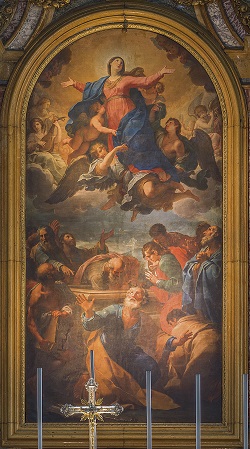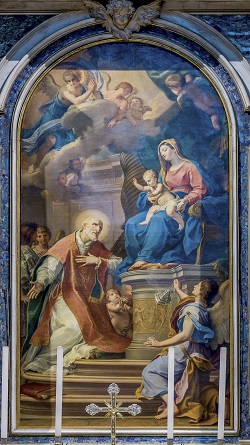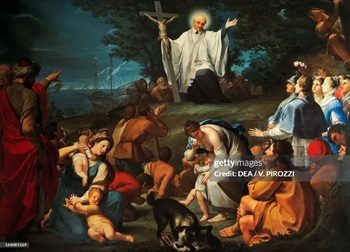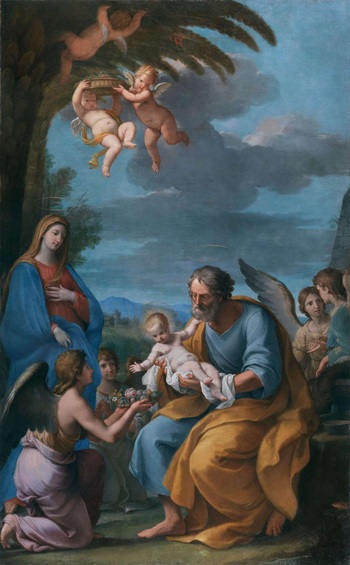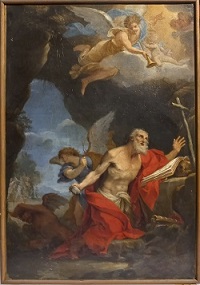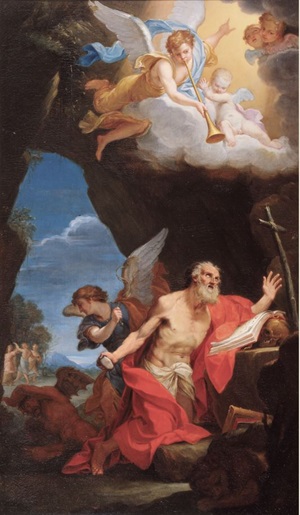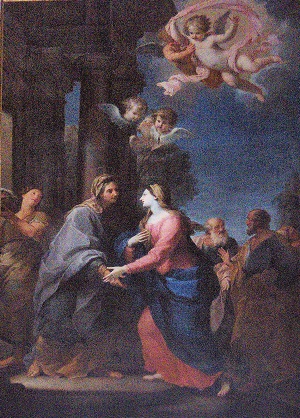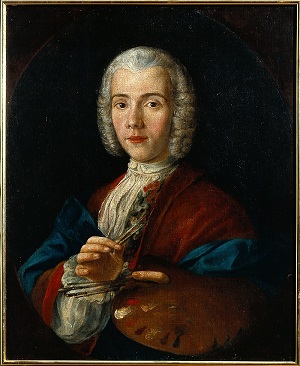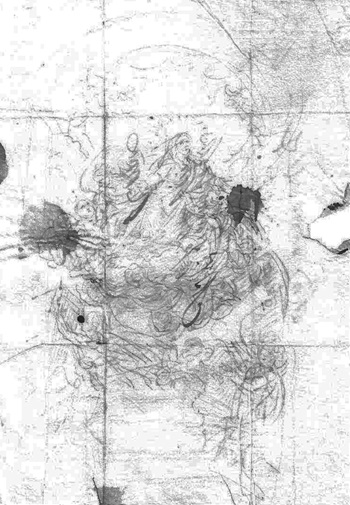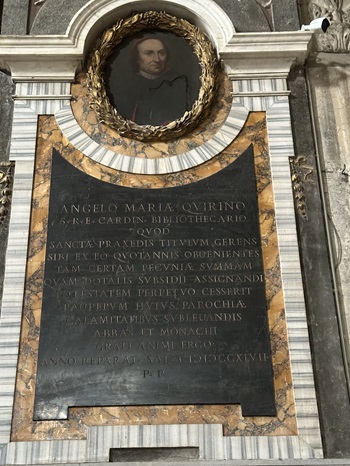Maurilio Lovatti
Giacomo Zoboli and Cardinal Querini
Rome and Brescia in XVIII century
Giacomo Zoboli (1681-1767), sometimes referred to as Jacopo, one of the greatest and most famous Italian painters of the Eighteenth century, born in Modena, after having painted for a few years in his city, moved to Rome around 1712-13, and worked mainly in the capital. Many of his masterpieces are visible in the churches of Rome, in particular in the basilicas of Santi Carlo e Ambrogio al Corso, Sant'Eustacchio, Sant'Apollinare, Santa Maria in Trastevere and in the church of San Giovanni della Pigna. His paintings were also commissioned by the Monastery of the Visitation in Madrid and the Monastery of the Holy Cross in Coimbra in Portugal. In Rome his fame grew steadily: in 1718 he became a member of the Accademia dei Virtuosi al Pantheon and in 1725 of the prestigious Accademia di San Luca, to the point of being considered in Rome, in his time, after the death of Sebastiano Conca, as the greatest living painter after Pompeo Batoni. In Brescia, three paintings of religious subjects by Zoboli are preserved: the altarpiece of the Assumption of the high altar of the Duomo Nuovo, Saint Philip Neri kneeling before the Virgin Mary, in the Church of Santa Maria della Pace and the Assumption and the Angels, altarpiece of the high altar of the old church in the Chiesanuova district.
The
presence of these important works by the Modena painter in the Lombard city
is certainly due to the Venetian Cardinal Angelo Maria Querini,
Bishop of Brescia from 1727 to 1755. Querini, remembered above all as the
founder and patron of the Queriniana Library in Brescia, opened to the
public in 1750, among the most learned scholars of the eighteenth century,
was on friendly terms with the Popes of the time, in particular Innocent
XIII (1721-1724), Benedict XIII (1724-1730) and Clement XII
(1730-1740), while with Benedict XIV (1740-1758) he had several
veiled controversies. Querini corresponded with European intellectuals, such
as Voltaire, and was even received by Newton. He was also
Prefect of the Vatican Library, member of the Accademia della
Crusca, the
Royal Academy of Berlin and the Academy of the Incogniti in Vienna.
Almost the same age as Zoboli, Querini, who was born in 1680, met the painter during
his time in Rome (from 1714 to 1721), before being appointed archbishop of
Corfu in 1723, then Venetian. Having arrived in Brescia in March 1728, after
being appointed cardinal on 26 November 1727, he immediately took care of
resuming work on completing the Duomo Nuovo (new Cathedral). In fact,
construction work on the Brescia cathedral had begun way back in 1604, when
the Venetian Marino Zorzi was bishop, but it had proceeded very
slowly, both due to lack of money and the plague epidemic, which had caused
an interruption from 1630 to around 1670. When Cardinal Querini arrived in
Brescia, there were practically only the walls, the roof of the cathedral,
the apse and the two front chapels. The high altar, the presbytery and the
choir were not yet built , as well as
the dome. To paint the altarpiece of the high altar Querini personally chose
and commissioned Giacomo Zoboli in 1732. The work that we can still admire
today was positioned in 1735 and is considered by scholars to be a very
successful work, which shows inventive ability and a wise use of color.
The Assumption of the Virgin Mary with the
Apostles by Giacomo Zoboli, main masterpiece in Duomo Nuovo,
Brescia (1733-1735)
The large painting (650 by 350 cm) was executed entirely in Rome, as the Bishop
himself informs us in his pastoral letter of 2 August 1732. In this letter
Cardinal Querini communicates that the same high altar of the cathedral,
composed of ancient marbles and gilded bronzes, was made in Rome and
exhibited, before being transported to Brescia, in Palazzo Venezia, his
Roman domicile (his nomination as Cardinal had made him titular of the
annexed basilica of San Marco Evangelista). The Cardinal adds, referring to
Giacomo Zoboli: “Ordinammo nell'istesso tempo
pure a Roma il gran quadro che ha da occupare tutta la facciata di mezzo del
coro, avendo scelto a tal fine uno dei più eccellenti, ed accreditati
Pennelli di questa Città” (At the same time we also ordered in
Rome the large painting that is to occupy the entire central facade of the
choir, having chosen for this purpose one of the most excellent and
accredited painters of this city). Considering that at that time
the majority of the people were illiterate, the paintings in the churches,
and even more so in the cathedral, had an educational and almost
catechetical function, and evidently Bishop Querini considered Zoboli's
style particularly suitable for transmitting the authentic meaning of the
Assumption of the Virgin, which at that time was not yet a dogma of the
Catholic Church (it was proclaimed by Pope Pius XII in 1950) but was deeply felt by
the Christian people, in particular after the Council of Trent.
Zoboli was perhaps initially inspired by Moretto's Assumption,
present in the Duomo Vecchio (there is no evidence that he came to
Brescia), but he worked in a creative and dynamic way. He also compared
himself with Emilian models, first of all the Carracci brothers, and with
the grandiose and rhetorical compositions "alla romana", a legacy
of his training in the capital. Certainly one of the models that inspired
him was The Assumption of the Virgin (1593) by Agostino Carracci (1557-1602)
for the Zaniboni chapel of San Salvatore in Bologna, today preserved
in the Pinacoteca Nazionale of the Emilian city. Almost certainly the main
source from which he drew inspiration, given the notable analogies, is the
"Madonna
Assunta" by Francesco Bassano Dal Ponte (1549-1592), the main
altarpiece of the church of San Luigi dei Francesi in Rome, which is also
two hundred metres from the basilica of Sant'Eustachio, for which Zoboli
created between 1727 and 1729 the two paintings that made him famous (the Visitation
and Saint Jerome Listening to the Trumpet of the Last Judgement).
Like Carracci and Bassano, along the arched canvas Zoboli places the
apostles in the lower part and the Virgin in the upper part, supported by
flying angels, who opens her arms and is depicted in a slight twist. The
lower part of the painting, where the apostles are depicted, is the
liveliest and has the greatest visual impact. The apostles are depicted with
very eloquent and suggestive facial expressions, which show attitudes of
amazement, fear, devotion, awareness of the extraordinary nature of the
event they are experiencing. In the center is Peter and around him the
painter arranges his companions symmetrically, all arranged around the
sarcophagus where they had laid and watched over the body of the Virgin Mary
before she was assumed into heaven. Zoboli shows a certain realistic
modernity in the cut of the bodies of the apostles placed to the side.
Emphasis, crowding of twisting figures and bright colours characterise the
entire work, completed in 1735, and derive from the Roman pictorial
environment, in which Zoboli trained and was influenced by Guido Reni
(1575-1642), Carlo Maratta (1625-1713) and his friend Sebastiano
Conca (1680-1764) and are emblematic of a pictorial style very different
from the Venetian one then predominant in Brescia and in the other cities of
the Republic of Venice. Precisely for this reason Cardinal Querini
had chosen Zoboli. Querini loved the academic style of Roman painters and
the theatrical, scenographic, even spectacular effects of Roman painting of
the time. Giacomo Zoboli had in fact already painted two paintings for Pope Benedict
XIII in Rome, later donated by Pope Pius IX to the Basilica of Santi
Ambrogio
e Carlo al Corso, where they are still located, in which the influence
of Guido Reni is at its maximum.
Querini's choice proved to be a good one, and Zoboli's painting was a great
success, even popular. When on April 21, 1737, Easter Sunday, the Bishop
celebrated the first holy mass at the new altar in front of Zoboli's altarpiece,
in a sort of solemn inauguration, a large crowd gathered in the square in
front. Querini intended the ceremony to be reserved for the city authorities
and noble families, as was the custom at the time. But the crowd was such
that the guards sent by the Podestà were unable to contain the crowd
that wanted to see the new altar and Zoboli's painting, and so the Podestà
himself decided to allow everyone access to the cathedral. Antonio Fappani
wrotes: “Il grande evento,
sottolineato da un elevato discorso del cardinale, è celebrato in sonetti,
stampe, medaglie commemorative che ne diffondono l'eco nella Penisola
italica e oltre i suoi confini” (The great event, underlined by an
elevated speech by the Cardinal, is celebrated in sonnets, prints,
commemorative medals that spread its echo in the Italian peninsula and
beyond its borders).
The great success achieved by the altarpiece of the Assumption, induced a few years later the Philippine Fathers della Pace (a church in Brescia) to commission Zoboli to paint the most important painting of the church then under construction, the one dedicated to Saint Philip Neri, the founder of the Congregation of the Oratory of the Philippine Fathers. The first stone of the new church of Santa Maria della Pace had been laid on 15 September 1720 and the work had proceeded quite rapidly, for the times, and already in 1736 the dome was being built. In 1737 Cardinal Querini donated to the church the altarpiece of the high altar, the Presentation of Jesus at the Temple, by Pompeo Batoni (1708-1787) born in Lucca, but also living and working in Rome. The Philippine Fathers, after an unsuccessful attempt to involve Sebastiano Conca, decided on 24 April 1742 to commission the altarpiece of the altar dedicated to Saint Philip Neri from Zoboli.
Thus was born Saint Philip Neri kneeling before the Virgin Mary, an oil on canvas, a large painting (447 by 223 cm) that Zoboli completed in Rome during 1745 (in the Farnese Palace, where he lived and worked since 1738) and which we can still admire today in the second altar of the right nave of the Chiesa della Pace.
Saint Philip Neri kneeling before the Virgin Mary by Giacomo Zoboli (1745)
The painter, before proceeding to create the painting for the church of Peace, had painted an almost identical one, but much smaller (98 by 49.5, oil on canvas) now preserved in the Civic Museum of Modena, which served as a model for the Peace one. The differences between the two works, apart from the dimensions, are minimal: in the Peace painting the open book and the white lily on the steps at the feet of San Filippo Neri are missing, which are present in the Modena one. The altar of the church of Peace where Zoboli's painting is located was donated by the Marquis Pietro Emanuele Martinengo Colleoni, while the painter's fee was paid by the Philippine Fathers, who had justified the choice of Zoboli by citing the success obtained by the main altarpiece of the Cathedral. The painting of Peace features bright and vivid colors like that of the cathedral, but is characterized by a more intense luminosity, combined with colder and more delicate tones, probably aimed at enhancing the figure of Saint Philip Neri, founder of the Congregation, who appears in the foreground and at the center of the viewer's attention. The compositional scheme of the work is very successful: the positioning of the characters determines an evident effect of depth and an overall harmony.
In 1748 Giacomo Zoboli created a third painting for Brescia, in addition to those of the cathedral and of the church of Peace, requested by the Augustinian nuns for the high altar of the church of Santa Maria degli Angeli, annexed to their convent located in the current Via Bassiche, with a fee of 370 Roman silver scudi (equal to approximately 210 Venetian gold sequins). The high altar of the church had been created the previous year by the architect Domenico Carboni (1727-1768), while the statues that adorn it are the work of Antonio Calegari (1699-1777), the sculptor who created the bust of Querini for the atrium of the Queriniana library and that of Alessandro Fè in the church of Santi Nazaro e Celso.
The Assumption of the Vergin Mary by Giacomo Zoboli (1748). High altarpiece of the Chiesa vecchia dell'Assunta, in Brescia, Chiesanuova district
That Zoboli
painted this canvas, depicting the Assumption of Mary, and that during the
18th century it was placed in the church of Santa Maria degli Angeli
is beyond any doubt: the painting is mentioned in a manuscript of 1751,
preserved in the Queriniana Library in Brescia, by don Francesco
Maccarinelli, and later in
1760 in a book by Giovanni Battista Carboni. Both sources report that
Giacomo Zoboli's Assumption was placed on the high altar of the
church in Via Bassiche. Until 2005 it was believed that this last painting
by Zoboli in Brescia had disappeared and could no longer be found. In 1981
Bruno Passamani, referring to this painting, wrote: “oggi non è reperibile neppure in altra ubicazione”
(Today it is not available anywhere else either) and again in 2001
Pier Vigilio Begni Redona claimed that Zoboli's canvas no longer existed.
Instead, in the context of the restoration work on the old church begun in
1999, promoted by don Arturo Balduzzi, parish priest of Chiesanuova from
1997 to 2010, the laboratory of Alessandra Viviani and Venusia Orsini, in
restoring the painting on the high altar, brought to light in 2004 the
certain and unequivocal signature of Giacomo Zoboli and attested to it in
the report of the works (2005). In the previous decades the painting had
been attributed, without any certainty and on the basis of hypothetical
elements, to the painter from Salò Sante Cattaneo (1739-1819) of
whom there are various paintings in the churches of Brescia.
The surprise was great. Zoboli's third Brescian painting had suddenly
reappeared after two centuries of oblivion. How had it arrived in
Chiesanuova? There are no documents attesting to the transfer of the
painting and the exact date of its arrival in Chiesanuova is not known.
However, it is possible to reconstruct what happened, very plausibly, and
with reference to the events of the period of Napoleonic rule in Italy.
After Napoleon Bonaparte's first Italian campaign (1796), a Decree of the
Provisional Government of Brescia of 30 September 1797 suppressed all male
and female religious orders and the Decree of the Executive Directory of the
Cisalpine Republic of 9 March 1799 included among the convents to be
suppressed that of the Augustinian nuns. In fact, after the Peace of
Campoformio (17 October 1797), the territory of Brescia had become part of
the Cisalpine Republic. The friars and nuns had to leave the convents which,
with their assets, were confiscated by the State and largely sold to raise
money. However, the actual evacuation of the convent of the Augustinian nuns
in via Bassiche took several years, because the expropriation process was
first delayed by the occupation of Brescia by Austro-Russian troops (from
April 1799 to June 1800) and then by the fact that the Augustinian convent
temporarily housed nuns from other congregations, mainly the Dominicans and
the Carmelites, who had had to leave their respective convents expropriated
by the Cisalpine Republic. Certainly in 1804 the convent was
already State property, assigned to the Municipality of Brescia to be
used as a warehouse. In fact in that year three altars from the church were
put up for auction, including that of Carboni. However, the offers were not
considered appropriate by the State Property Offices and in the end, on 30
June 1808 the Minister of Finance wrote to the Deputies of the Fabbrica
del Duomo that Prince Eugene de Beauharnais, viceroy of Italy, “si è degnato di accordare
gratuitamente l'altare maggiore esistente nella soppressa Chiesa degli
Angioli” (He deigned to grant free use of the existing high
altar in the suppressed Church of the Angels), hus meeting the
cathedral's request. A few weeks later the altar was dismantled and
transferred to the Duomo Nuovo. It should be remembered that, in
accordance with the Concordat between the Cisalpine Republic and Pope Pius
VII of 16 September 1803, the properties of all parishes and other
non-parish churches intended for worship by the faithful who lived in areas
far from the parish were protected by the State (and among the latter was
the church of the Assunta di Bottonaga, as the locality of Chiesanuova
was still officially called at the time). Finally, on 10 March 1808 a Decree
signed by Eugene de Beauharnais included the church of San Francesco among
those to be preserved for worship in the territory of the parish of San
Nazaro e Celso, but not that of Santa Maria degli Angeli. This
regulatory framework explains the transfer of Giacomo Zoboli's Assumption
from the Church of Santa Maria degli Angeli to Chiesanuova. 1808
certainly represents the date by which the transfer of Zoboli's Assumption
to Chiesanuova must have occurred. But it is very likely to suppose that, if
the intention was to remove the painting from the State property to place it
in a church in the territory of the parish of Saints Nazaro and Celso, the
removal of the painting from the high altar in via Bassiche occurred before
1804, because it would have been very imprudent to leave it in the sight
of state officials who had to evaluate the appropriateness of the offers for
the auction relating to the attempted sale of the three altars of the church
of Santa Maria degli Angeli. With good approximation, it can
therefore be reasonably assumed, on the basis of all the available elements,
that the painting was removed from its original location between 1801 and
1803, even if, in principle, it is possible but very unlikely that this
occurred even earlier, starting from 9 March 1799, the official date of
suppression of the convent of the Augustinian nuns. Since the moving of the
painting had the precise purpose of preserving it, the choice of Chiesanuova,
as a non-parish church open to worship, could have matured after the
Concordat, and considering that the Concordat between the Church and the
Cisalpine Republic dates back to September 1803, the most likely period for
the transfer of the painting could be the last quarter of 1803. Since
there are no written documents on the transfer and delivery of Zoboli's
Assumption to Chiesanuova (since it was a formally illegal operation), we
cannot know precisely the role played by the Provost, monsignor Carlo
Appiani, parish priest of the collegiate church of Santi Nazaro e Celso from 1792 to 1818,
and by don Pietro Poli, curate of Chiesanuova from 1783 to 1816. The
decision to transfer the painting to Chiesanuova could have been taken by
Monsignor Appiani himself or, even if this were not the case, it seems very
likely that he at least authorized it. In fact, it is unlikely that the
curate of Chiesanuova could have accepted the painting without informing the
parish priest of San Nazaro, on which the church of Bottonaga depended (Chiesanuova
would be an autonomous parish only from 1956).
The Assumption
of Chiesanuova by Giacomo Zoboli (oil on canvas, 340 x 165 cm) presents some
analogies with the most famous painting of the cathedral: the chromatic
choices, the vaporous folds of the clothes and the almost affected grace of
the gestures are very similar. But the differences are more evident, even at
first glance. The painting of Chiesanuova is structurally divided into two
parts. Maintaining a similar arrangement to the Assumption of the
Cathedral, Zoboli in this case opts for a ‘poorer’ composition: in the
upper part the Assumption of the Virgin, in the lower part, three angels
take the place of the apostles, representing the scene of the astonishment
of the empty tomb. The setting of the painting is certainly more celestial
and not dramatic, since Zoboli abandons the impetuous and vibrant use of chiaroscuro,
classic of Caravaggio, which he had instead chosen for the altarpiece
of the Cathedral.
The upper scene mirrors the lower one of the angels ‘in an interlocking
way’, without however taking away the centrality of the Virgin, indeed, a
line accompanies the viewer’s gaze from below, bringing it back towards
the main scene by means of the raised arm of the angel in the foreground.
The scene in its complexity appears simple, harmonious and not chaotic. The
angels, aware of what is happening, assist the Madonna in the Assumption. In
the background of the lower scene, an angel is intent on scattering white
lily flowers in the tomb, as if to symbolize the totality of the Virgin’s
purity, throughout her life. The angel in the foreground shows a
communicative ability expressed in a few gestures, but with a strong impact:
resting on the white cloth that comes out of the tomb, and pointing to it,
he almost seems to speak, capturing the viewer’s attention. Although it is
a classical iconography, Zoboli’s work is characteristic for the wise use
of compositional space. The colors are soft, pastel, as if to signify that
the community of believers must not be afraid of God, but can and must
welcome him in a community spirit.
It can therefore be assumed that the difference lies in the message. In the
Cathedral Assumption, Zoboli almost tends to alarm and surprise the
viewer, while in the Chiesanuova painting the angel presents himself to the
viewer as a guide, revealing what the faithful already knows deeply. The Virgin
Mary has her arms wide open and her face is depicted frontally, unlike the
other two Brescian paintings, with a gaze turned upwards and with a serene
and confident, almost ecstatic expression. Considering the linear
perspective, we find the open arms of the Virgin, who loses the intertwined
position, of Raphaelesque inspiration, and is here depicted, relaxed and
seated.
Furthermore, between 1735, when he completed the altarpiece for the Duomo, and 1748, when he painted the painting for Santa Maria degli Angeli, Zoboli was the protagonist of a stylistic evolution that brought him to full maturity. After his fame had spread following the two masterpieces found in the Basilica of Sant'Eustacchio in Rome, near the Pantheon (the Visitation and Saint Jerome, 1727-29), in those years he was busy on several fronts: in 1737 he painted the Sermon of Saint Vincent de Paul, later donated to Pope Clement XII, and The Death of Saint John Francis Regis, in the church of the Gesù. In 1748 he also completed the altarpiece for the altar of the chapel of Saint Joseph, in the right nave of the Basilica of Sant'Apollinare, near Piazza Navona (unfortunately known to most not for its artistic masterpieces, but because Enrico De Pedis, a famous bandit of the "Magliana gang", was inappropriately buried there for a certain period). In this splendid painting (known as The Holy Family) Mary, this time portrayed in profile, contemplates with a gaze overflowing with serenity the Baby Jesus in Joseph's arms.
(I thank dr. Lucia Garofalo for her advice regarding the pictorial analysis of the Assumption of Chiesanuova)
Giacomo Zoboli, The Sermon of Saint Vincenzo de' Paoli, Palazzo Corsini alla Lungara, Rome (1737)
Giacomo Zoboli, Holy Family, in the Basilica di Sant'Apollinare, Rome (1748)
Postscript n. 1 (21 september 2022)
After being appointed "academic of merit" at the Accademia di San Luca in Rome in 1725, Giacomo Zoboli, as was his custom, donated to the same Academy in 1729 a small painting, oil on canvas (archive of the Academy, v. 49, f. 63 v., 1729) entitled San Girolamo ascolta la tromba del Giudizio Universale. It is the model used by Zoboli for the large painting that in that same 1729 he was completing for the right transept of the Basilica of Sant'Eustachio in Rome.
The differences between the model and the painting of the basilica are truly minimal and difficult to perceive. In particular, in creating the painting for the basilica of Sant'Eustachio, Zoboli slightly modified the shape of the tree branches to the left of the painting. It may be interesting to note that sixteen years later, in creating the painting Saint Philip Neri kneeling before the Vergin for the church of Santa Maria della Pace in Brescia in 1745, the painter allowed himself more significant variations compared to the model preserved in the Civic Museum of Modena. In fact, in the large painting of the church of the Pace, the open book and the white lily on the steps at the feet of Saint Philip Neri that are present in the Modena model are missing.
San Saint Jerome Listens to the Trumpet of the Last Judgement
(painting preserved in the deposit of the Gallery dell'Accademia Nazionale di San Luca, Rome)
Saint Jerome in Meditation (cm 131 x 77.5)
(preserved in the Bper Gallery in Modena, copy made by Zoboli "in memory" of the painting donated to the Accademia di San Luca)
Postscript n. 2 (21 september 2022)
An example of "defamation" about Giacomo Zoboli
For various reasons, which we cannot examine here, Giacomo Zoboli did not receive much consideration from art historians in the 19th and 20th centuries. Only starting from the studies of Professor Maria Barbara Guerrieri Borsoi in the 1980s has his figure been reevaluated as it deserves, that is, as the greatest exponent of the Roman school of the 18th century, after Sebastiano Conca (1680-1764).
In some cases, Zoboli has been the object of real and unjustified defamation. I cite an emblematic example. In 1826, Paolo Brognoli from Brescia, describing the Duomo Nuovo in Brescia, wrote:
"Benché
il quadro dell'altar maggiore abbia segnato per autore Giacomo Zoboli, ella
è però cosa certa essere opera del suo maestro Sebastiano Conca, dipinta
in Roma nel 1773, e non si può supporre altro, se non che il Conca ciò
abbia fatto per dare in paese straniero maggior credito al pennello del suo
allievo. Esprime il dipinto Maria Vergine assunta al cielo con gli apostoli
attorno al di lei sepolcro posti con arguta invenzione, giusta disposizione,
bel colorito, sicché lo spettatore con piacere lo ammira. Ho inteso da
molti forestieri conoscitori delle opere di Conca in Roma, essere questa una
delle migliori produzioni del suo pennello." (P. Brognoli, Nuova
guida per la città di Brescia, Federico Nicoli-Cristiani Tipografo,
Brescia 1826, pp. 44-45). (Although the painting on the high altar was
signed by Giacomo Zoboli, it is certain that it is the work of his master
Sebastiano Conca, painted in Rome in 1773, and one cannot suppose anything
other than that Conca did this to give greater credit to the brush of his
pupil in a foreign country. The painting expresses the Virgin Mary assumed
into heaven with the apostles around her tomb, placed with witty invention,
correct disposition, beautiful coloring, so that the spectator admires it
with pleasure. I have heard from many foreign connoisseurs of Conca's works
in Rome, that this is one of the best productions of his brush.)
Along Brognoli's interpretative lines, in 1882 the historian from Brescia Federico
Odorici (1807-1884) wrote: "l'Assunta di Giacomo Zoboli,
per quanto dicesi diretta dal Conca: quadro lodato per grandiosità di
pensiero e larghezza d'impasto; ma in quelle gigantesche figure si evidente
risulta il corretto e fiero disegno del Conca, che sarei per dirle tutte sue."
(F. Odorici, Guida di Brescia: rapporto alle arti e ai
monumenti antichi e moderni, S. Malaguzzi, Brescia 1882, p. 32) (Giacomo
Zoboli's Assumption, which is said to have been directed by Conca: a
painting praised for its grandiose thought and breadth of impasto; but in
those gigantic figures the correct and proud design of Conca is evident, and
I would be inclined to call them all his).
Brognoli had therefore published a series of false information, later reported several times by various authors of the 19th century. In particular:
- IT IS FALSE that the altarpiece of the Assumption was painted in 1773, firstly because in that year both Zoboli and Conca had already died (in reality it was painted by Zoboli in Rome between 1733 and 1735, and inaugurated together with the altar on 21 April 1737, as we have seen).
- IT IS FALSE that Zoboli was a pupil of Conca, of whom he was only one year younger. Zoboli had as teachers first Francesco Stringa in Modena and then Giovan Gioseffo Dal Sole in Bologna in the early eighteenth century (most likely from 1701 to 1707, considering that from 1707 to 1712 his presence is attested again in Modena, when he worked on the frescoes of the Galleria Estense under the direction of Stringa and then, after the latter's death in 1709, of Jacopino Consetti). During the period (1733-35) in which he painted the Assumption now in the Cathedral of Brescia, he had his own workshop in Rome and resided in Piazza del Gesù, without any kind of dependence on Sebastiano Conca.
- IT IS FALSE that Conca had an interest in giving "greater credit" in a "foreign country" (i.e. Brescia) to Giacomo Zoboli, who was actually a competitor of Conca himself, as shown by the case of the painting in the church of Pace in Brescia, as we have seen.
Perhaps Brognoli is right only in one point, when he reports that several of his acquaintances affirm that the altarpiece in the Cathedral of Brescia is at the level of the "best productions" of the brush of Sebastiano Conca in Rome (he is probably referring to Santa Cecilia in Gloria of 1725, in the basilica of Santa Cecilia in Trastevere and to La Vergine Assunta e San Sebastiano (The Virgin of the Assumption and Saint Sebastian) of about 1740, in the church of Santi Luca e Martina in the Roman Forum). Incredible but true, it seems that the hypothesis of the attribution of the painting of the Assumption to Conca rather than to Zoboli is based exclusively on his personal opinion that the painting was "too beautiful" to be by Zoboli, despite all the documents, starting from those of the commissioner, Cardinal Angelo Maria Querini, showing without a shadow of a doubt that the painting was made in Rome by Zoboli between 1733 and 1735.
Even on the website of the italian Ministry of Culture, false statements about Zoboli have been repeated, in particular regarding the dating of the altarpiece in the Duomo Nuovo in Brescia and the false information that Conca was Zoboli's teacher. See:
Italian Ministry of Culture factsheet on the Assumption of the Vergin Mary by Giacomo Zoboli
Even the
famous archaeologist Carlo Fea (1753-1836) in the various editions -
the first is from 1820 - of his guide to Rome, when describing the
Corsini Gallery writes "in the antechamber there are some modern
paintings by mediocre painters such as Zoboli, Masucci, Lucatelli and
Garzi" (C. Fea, Nuova descrizione di Roma e dei suoi dintorni,
4th ediz., Puccinelli, Rome 1824, p. 575) superficially grouping together
painters of very different fame and value.
The Visitation (1727)
left transept, Basilica di Sant'Eustachio, Rome
Self-portrait by Giacomo Zoboli
Museo civico in Modena
St. Matthew imposes the veil on Iphigenia (daughter of the Ethiopian king) and the Virgins, church of San Matteo, Pisa (1733-35)
drawing by Giacomo Zoboli for the Assumption commissioned by the Augustinian nuns for the church of Santa Maria degli Angeli in Brescia
in pencil, 24x17.5, preserved in Ariccia (Rome), Palazzo Chigi, Peretti donation, inv. FP17, published by Maria Barbara Guerrieri Borsoi, I disegni di Giacomo Zoboli (1681-1767) nel Museo Barocco di Ariccia, in M. B. Guerrieri Borsoi, F. Petrucci (ed.), Il museo del Barocco romano, De Luca, Rome 2008, p. 89-152, on p. 123.
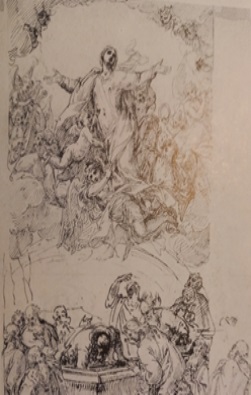
drawing by Giacomo Zoboli for the Assumption at the main altar of the Duomo nuovo in Brescia
published by Maria Barbara Guerrieri Borsoi, Disegni di Giacomo Zoboli, De Luca, Rome 1984, p. 80-81
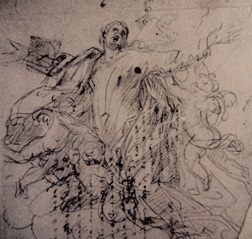
sketch by Giacomo Zoboli for the position of the Virgin Mary in the painting of the Assumption at the main altar of the Duomo nuovo in Brescia,
published by Maria Barbara Guerrieri Borsoi, Disegni di Giacomo Zoboli, De Luca, Rome 1984, p. 80-81
Giacomo Zoboli, portrait of Cardinal Angelo Maria Querini in the basilica of Santa Prassede in Rome
(Querini was titular cardinal of Santa Prassede from 1743 to 1755)
Painting by Giacomo Zoboli in Rome, Modena, Brescia and in other locations (in italian)
Documents about death an burial of Giacomo Zoboli
Saint Philip Neri kneeling before the Virgin Mary (1745) by Giacomo Zoboli in the church of Santa Maria della Pace in Brescia
- Giacomo Zoboli (1681-1767) Treccani -Dizionario biografico degli italiani (in italian)
- Giacomo Zoboli (1681-1767) Wikipedia
